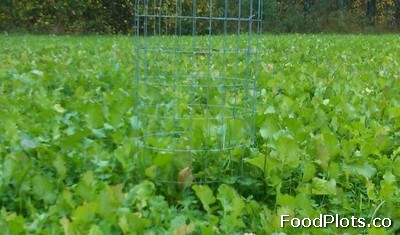Hunters love food plots almost as much as the animals that they are intended to feed. In fact, the planting of deer food plots is possibly the most implemented and, in many cases, the least needed wildlife management practice across the whitetail’s range. Many landowners and hunters alike believe that food plots provide everything that any animal will need, but the truth of the matter is that food plots typically make up only a very small percent of land cover.
The key elements for wildlife survival are food, water, cover, and space. Food is seldom a limiting factor for wildlife in the southern United States due to the mild climate and high plant diversity. That being said, food plots can still offer excellent hunting for deer, turkey, quail and dove because they can concentrate wildlife and make them more predictable. Food plots can be increasingly important in the northern US, where winter temperatures decrease rapidly as latitude increases.

Good habitat is often the limiting factor that determines the abundance of local wildlife populations, but food plots can be an important piece of the puzzle when they are properly implemented. Of course, it is always important to weigh the advantages and disadvantages of any habitat management practice prior to implementation to see if it fits into the overall wildlife management plan for your property. Without a doubt, one of the big advantages of food plots is that they can concentrate animals for viewing and/or harvest.
Whitetail deer and wild turkey often take to a new food plot quite readily, especially winter plots. These winter forage sites can provide a critical source of late winter food and even cover for other wildlife. This is particularly true in years of low production of native food sources or during extremely severe winters. In most places, winter food plots tend to be more successful than spring or summer food plots for both attracting wildlife and serving the animal’s nutritional needs.
Food plots can be as simple or complicated as someone wants them to be. Soil disturbance resulting from food plot establishment is often of greater value to wildlife than grain production due to regrowth of high quality native forbs. This is especially true for quail and dove hunting, but also for other game species too. Do not underestimate the value of a native food plot that is created by simply strip disking an area.
A common mistake many hunters make is not adequately preparing their plots. Food plots need to be maintained and treated like real crops for hunters and wildlife to get maximum benefit. This requires a lot of work each year on the part of the landowner or manager, so always make sure that you start with high quality seed. In addition, many think food plots can be used to artificially inflate the number of animals the land can support. This is a bad idea. It is, however, a good practice to consider food plots a small part of a comprehensive wildlife management plan.
My brother was telling me about his interest in getting a food plot started the other day. I did not know what that was and wanted to learn more about it, how they can benefit deer that use our property. It seems to be a good way to help wildlife other than standards agriculture or feeders.
Alexandria, food plots are a great way to provide forage for wildlife. It’s hard to beat native plants when they are available, but often times these forages are missing from the system, for a variety of reasons. Planted forages, food plots are great way to attract animals, hold animals on a property.